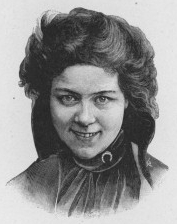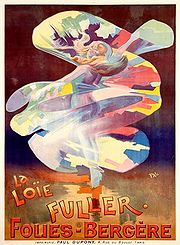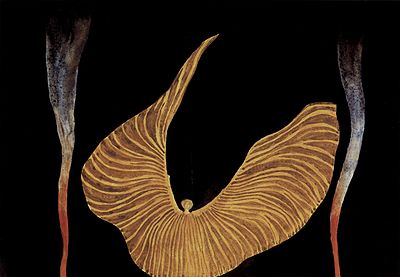
Loie Fuller
Encyclopedia


Modern dance
Modern dance is a dance form developed in the early 20th century. Although the term Modern dance has also been applied to a category of 20th Century ballroom dances, Modern dance as a term usually refers to 20th century concert dance.-Intro:...
and theatrical lighting
Stage lighting
Modern stage lighting is a flexible tool in the production of theatre, dance, opera and other performance arts. Several different types of stage lighting instruments are used in the pursuit of the various principles or goals of lighting. Stage lighting has grown considerably in recent years...
techniques.
Career
Born Marie Louise Fuller in the ChicagoChicago
Chicago is the largest city in the US state of Illinois. With nearly 2.7 million residents, it is the most populous city in the Midwestern United States and the third most populous in the US, after New York City and Los Angeles...
suburb of Fullersburg, now Hinsdale, Illinois
Hinsdale, Illinois
Hinsdale is a suburb of Chicago, Illinois; it is located partly in Cook County and mainly in DuPage County in the U.S. state of Illinois. The population was 17,349 at the 2000 census. The town's ZIP code is 60521. The town has a rolling, wooded topography, with a quaint downtown and is a 30-minute...
, Fuller began her theatrical career as a professional child actress and later choreographed
Choreography
Choreography is the art of designing sequences of movements in which motion, form, or both are specified. Choreography may also refer to the design itself, which is sometimes expressed by means of dance notation. The word choreography literally means "dance-writing" from the Greek words "χορεία" ...
and performed dance
Dance
Dance is an art form that generally refers to movement of the body, usually rhythmic and to music, used as a form of expression, social interaction or presented in a spiritual or performance setting....
s in burlesque
American burlesque
American Burlesque is a genre of variety show. Derived from elements of Victorian burlesque, music hall and minstrel shows, burlesque shows in America became popular in the 1860s and evolved to feature ribald comedy and female striptease...
(as a skirt dancer), vaudeville
Vaudeville
Vaudeville was a theatrical genre of variety entertainment in the United States and Canada from the early 1880s until the early 1930s. Each performance was made up of a series of separate, unrelated acts grouped together on a common bill...
, and circus shows. An early free dance
Free dance
Free dance is a 20th century dance form that preceded modern dance. Rebelling against the rigid constraints of classical ballet, Loie Fuller, Isadora Duncan and Ruth St. Denis developed their own styles of free dance and laid the foundations of American modern dance with their choreography and...
practitioner, Fuller developed her own natural movement and improvisation
Improvisation
Improvisation is the practice of acting, singing, talking and reacting, of making and creating, in the moment and in response to the stimulus of one's immediate environment and inner feelings. This can result in the invention of new thought patterns, new practices, new structures or symbols, and/or...
techniques. Fuller combined her choreography with silk
Silk
Silk is a natural protein fiber, some forms of which can be woven into textiles. The best-known type of silk is obtained from the cocoons of the larvae of the mulberry silkworm Bombyx mori reared in captivity...
costumes illuminated by multi-coloured lighting of her own design.

United States
The United States of America is a federal constitutional republic comprising fifty states and a federal district...
through works such as Serpentine Dance (1891), she felt that she was not taken seriously by the public who still thought of her as an actress. Her warm reception in Paris
Paris
Paris is the capital and largest city in France, situated on the river Seine, in northern France, at the heart of the Île-de-France region...
during a European tour persuaded Fuller to remain in France
France
The French Republic , The French Republic , The French Republic , (commonly known as France , is a unitary semi-presidential republic in Western Europe with several overseas territories and islands located on other continents and in the Indian, Pacific, and Atlantic oceans. Metropolitan France...
and continue her work. A regular performer at the Folies Bergère with works such as Fire Dance, Fuller became the embodiment of the Art Nouveau
Art Nouveau
Art Nouveau is an international philosophy and style of art, architecture and applied art—especially the decorative arts—that were most popular during 1890–1910. The name "Art Nouveau" is French for "new art"...
movement. An 1896 film of the Serpentine Dance by the pioneering film-makers Auguste and Louis Lumière
Auguste and Louis Lumière
The Lumière brothers, Auguste Marie Louis Nicolas and Louis Jean , were among the earliest filmmakers in history...
gives a hint of what her performance was like. (The unknown dancer in the film is often mistakenly identified as Fuller herself.)

Artist
An artist is a person engaged in one or more of any of a broad spectrum of activities related to creating art, practicing the arts and/or demonstrating an art. The common usage in both everyday speech and academic discourse is a practitioner in the visual arts only...
s and scientist
Scientist
A scientist in a broad sense is one engaging in a systematic activity to acquire knowledge. In a more restricted sense, a scientist is an individual who uses the scientific method. The person may be an expert in one or more areas of science. This article focuses on the more restricted use of the word...
s, including Jules Chéret
Jules Chéret
Jules Chéret was a French painter and lithographer who became a master of Belle Époque poster art. He has been called the father of the modern poster. -Biography:...
, Henri de Toulouse-Lautrec
Henri de Toulouse-Lautrec
Henri Marie Raymond de Toulouse-Lautrec-Monfa or simply Henri de Toulouse-Lautrec was a French painter, printmaker, draughtsman, and illustrator, whose immersion in the colourful and theatrical life of fin de siècle Paris yielded an œuvre of exciting, elegant and provocative images of the modern...
, François-Raoul Larche
François-Raoul Larche
François-Raoul Larche was a French Art Nouveau sculptor whose work included several figures of Christ, but who may be better known for his numerous female figures, both nude and draped....
, Henri-Pierre Roché
Henri-Pierre Roché
Henri-Pierre Roché was a French author who was deeply involved with the artistic avant-garde in Paris and the Dada movement.- Biography :Roché was born in Paris, France. In 1898, he was an art student at the Académie Julian....
, Auguste Rodin
Auguste Rodin
François-Auguste-René Rodin , known as Auguste Rodin , was a French sculptor. Although Rodin is generally considered the progenitor of modern sculpture, he did not set out to rebel against the past...
, Franz von Stuck, Maurice Denis
Maurice Denis
Maurice Denis was a French painter and writer, and a member of the Symbolist and Les Nabis movements. His theories contributed to the foundations of cubism, fauvism, and abstract art.-Childhood and education:...
, Thomas Theodor Heine
Thomas Theodor Heine
Thomas Theodor Heine was a German painter and illustrator. Born in Leipzig, Heine established himself as a gifted caricaturist at an early age, which led to him studying art at the Kunstakademie Düsseldorf and, briefly, at the Academy of Fine Arts in Munich...
, Koloman Moser
Koloman Moser
Koloman Moser was an Austrian artist who exerted considerable influence on twentieth-century graphic art and one of the foremost artists of the Vienna Secession movement and a co-founder of Wiener Werkstätte....
, Stéphane Mallarmé
Stéphane Mallarmé
Stéphane Mallarmé , whose real name was Étienne Mallarmé, was a French poet and critic. He was a major French symbolist poet, and his work anticipated and inspired several revolutionary artistic schools of the early 20th century, such as Dadaism, Surrealism, and Futurism.-Biography:Stéphane...
, and Marie Curie. Fuller held many patent
Patent
A patent is a form of intellectual property. It consists of a set of exclusive rights granted by a sovereign state to an inventor or their assignee for a limited period of time in exchange for the public disclosure of an invention....
s related to stage lighting including chemical compounds for creating color gel
Color gel
A color gel or color filter , also known as lighting gel or simply gel, is a transparent colored material that is used in theatre, event production, photography, videography and cinematography to color light and for color correction...
and the use of chemical salt
Salt
In chemistry, salts are ionic compounds that result from the neutralization reaction of an acid and a base. They are composed of cations and anions so that the product is electrically neutral...
s for luminescent lighting and garments (stage costumes US Patent 518347). Fuller was also a member of the French Astronomical Society.
Loie Fuller's original stage name was "Louie". In modern French "L'ouie" is the word for a sense of hearing. When Fuller reached Paris she gained a nickname which was a pun on "Louie"/"L'ouie". She was renamed "Loïe" - this nickname is a corruption of the early or Medieval French "L'oïe", a precursor to "L'ouie", which means "receptiveness" or "understanding".
Fuller formed a close friendship with Queen Marie of Romania
Marie of Edinburgh
Marie of Romania was Queen consort of Romania from 1914 to 1927, as the wife of Ferdinand I of Romania.-Early life:...
; their extensive correspondence has been published. Fuller, through a connection at the U.S. embassy in Paris played a role in arranging a U.S. loan for Romania during World War I. Later, during the period when the future Carol II of Romania
Carol II of Romania
Carol II reigned as King of Romania from 8 June 1930 until 6 September 1940. Eldest son of Ferdinand, King of Romania, and his wife, Queen Marie, a daughter of Prince Alfred, Duke of Edinburgh, the second eldest son of Queen Victoria...
was alienated from the Romania
Romania
Romania is a country located at the crossroads of Central and Southeastern Europe, on the Lower Danube, within and outside the Carpathian arch, bordering on the Black Sea...
n royal family and living in Paris with his mistress Magda Lupescu
Magda Lupescu
Elena Lupescu , better known as Magda Lupescu, was the mistress of King Carol II of the Romanians and later , his wife.-Parents and siblings:...
, she befriended them; they were unaware of her connection to Carol's mother Marie. Fuller initially advocated to Marie on behalf of the couple, but later schemed unsuccessfully with Marie to separate Carol from Lupescu. With Queen Marie and American businessman Samuel Hill
Samuel Hill
Samuel Hill , usually known as Sam Hill, was a businessman, lawyer, railroad executive and advocate of good roads in the Pacific Northwest...
, Fuller helped found the Maryhill Museum of Art
Maryhill Museum of Art
The Maryhill Museum of Art is a small museum with an eclectic collection, located near Maryhill in the U.S. state of Washington.The structure was built as a mansion by entrepreneur Samuel Hill...
in rural Washington State, which has permanent exhibits about her career.
Fuller occasionally returned to America to stage performances by her students, the "Fullerets" or Muses, but spent the end of her life in Paris where she died of pneumonia on January 1, 1928 at age 65. She was cremated and her ashes are interred in the columbarium at Cimetière du Père Lachaise in Paris.
Continuing influence


.jpg)
Fuller continues to be an influence on contemporary choreographers. Among these are Jody Sperling who re-imagines Fuller’s genre from a contemporary perspective.http://www.timelapsedance.com
Written works
Fuller's autobiographical memoire "Quinze ans de ma vie" was written in French and published by F. Juven (Paris) in 1908 with an introduction by Anatole FranceAnatole France
Anatole France , born François-Anatole Thibault, , was a French poet, journalist, and novelist. He was born in Paris, and died in Saint-Cyr-sur-Loire. He was a successful novelist, with several best-sellers. Ironic and skeptical, he was considered in his day the ideal French man of letters...
. She drafted her memoires again in English a few years later, which were published under the title "Fifteen Years of a Dancer's Life" by H. Jenkins (London) in 1913. The New York Public Library Jerome Robbins Dance Collection holds the nearly complete manuscript to the English edition and materials related to the French edition.

